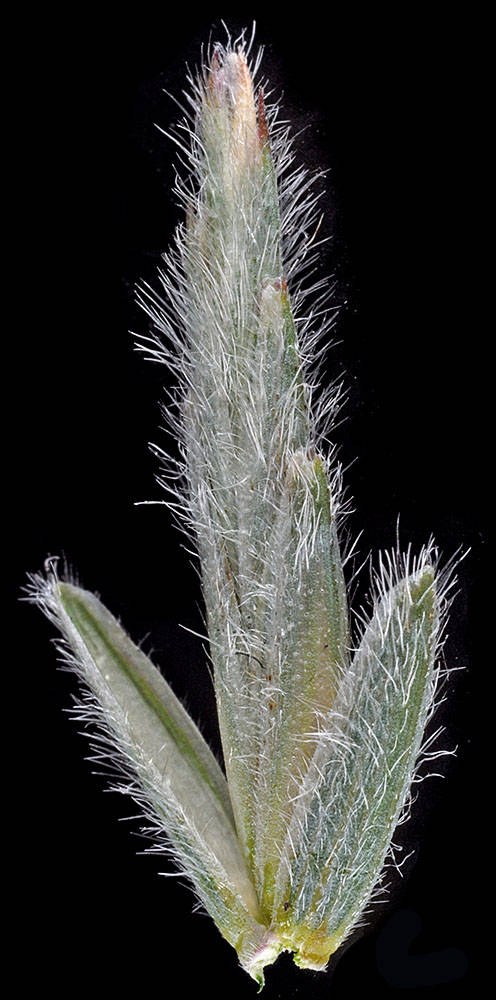Elymus lanceolatus
Elymus violaceus
(synonym of Elymus alaskanus)
thickspike wheatgrass
high wheatgrass
erect.
often decumbent or geniculate.
sheaths glabrous or pubescent;
blades 1.5–6 mm wide;
outer surfaces usually glabrous;
inner surfaces with appressed hairs.
sheaths glabrous;
blades 3–4 mm wide, glabrous or hairy;
lower surfaces less densely hairy and with shorter hairs than the upper surfaces.
3.5–26 cm; erect to slightly nodding, 1 spikelet per node but occasionally with 2 at a few nodes;
internodes 3.5–15 mm;
disarticulation above the glumes; beneath each floret.
(3)5–9 cm; erect, 1 spikelet per node;
internodes 4–5.5 mm;
disarticulation above the glumes; beneath each floret.
8–31 mm, 1.5–3 times longer than the internodes, appressed, 3–11 florets, glabrous or hairy;
hairs to 1 mm.
(9)10–15(17)mm, appressed; (3)4–5 florets;
rachillas hairy;
hairs about 0.4 mm.
5–14 mm, 50–75% the length of the adjacent lemmas, 0.7–1.3 mm wide, lanceolate, glabrous or hairy; smooth or scabrous, 3–5-veined; flat or weakly keeled;
keels straight;
margins narrow, tapering from the base or from beyond mid-length;
tips acute to acuminate, sometimes mucronate or short-awned.
8–12 × 1.2– 2 mm; about 75% as long as to equaling the adjacent lemmas, narrowly ovate to obovate, often purplish, glabrous or occasionally scabrous;
keels smooth but occasionally scabrous, 3(5)-veined, glabrous;
margins unequal; the wider margin 0.3– 1 mm wide, usually widest in the distal 33%;
tips acute to rounded, often awned;
glume awns; if present; to 2 mm.
7–12 mm, glabrous to densely long-hairy; all hairs similar, sometimes scabrous;
tips acute to awned;
lemma awns; if present; to 2 mm; straight.
(6.4)8–9.5 mm, glabrous to pubescent; all similar, usually awned;
lemma awns; if present, 0.5–3 mm; straight.
2.5–6 mm.
0.7–1.3 mm.
Elymus lanceolatus
Elymus violaceus
3 subspecies.
Elymus lanceolatus is a strongly rhizomatous wheatgrass that lacks or nearly lacks awns. It is most similar to Pascopyrum smithii, which has more basally concentrated leaves and glumes that taper from near the base and have curved midveins. It is also similar to E. trachycaulus, which is cespitose, has consistently glabrous lemmas, and has glumes 75–100% as long as the lemmas.
Dry to moist alpine meadows, talus, and shores of lakes and creeks. 2100–3000m. BW. ID, NV, WA; North to AK, northeast to Greenland, east to WY, southeast to NM. Native.
Elymus violaceus was recently split taxonomically from E. trachycaulus. Elymus violaceus has shorter anthers and more uneven glume margins than E. trachycaulus. Elymus trachycaulus growing at high elevations often has 3(5) glume veins and somewhat unequal glume margins, thus resembling E. violaceus.
Barbara Wilson, Richard Brainerd, Nick Otting
Barbara Wilson, Richard Brainerd, Nick Otting
- Local floras:
BC,
OR,
WA
- Local Web sites:
Flora NW,
PNW Herbaria
WildflowerSearch
iNaturalist (observations)
USDA Plants Database
- LBJ Wildflower Center
- SEINet
- Plants of the World Online
- Encyclopedia of Life
- Wikipedia
- Google Image Search




